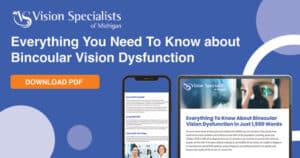Why Your Doctor May Not Know About Vision Misalignment
The history of Vertical Heterophoria (VH) While Vertical Heterophoria (or VH, a vertical image misalignment and a form of binocular vision dysfunction), isn’t exactly new, it certainly isn’t widely known. That’s because in the 1880s, Dr. George T. Stevens (who first described VH) attempted to correct it using prism that was too strong, and the result was not resoundingly successful. The next person to make significant contributions to the field of VH didn’t come along until the 1950s. Dr. Raymond Roy, an optometrist from Portland, Oregon, would cover one eye of a patient for 6 days, and then the other eye for 6 days to determine if VH was present. As you can imagine, this wasn’t popular with his patients or other medical professionals, and the field once again became buried. VH has been mentioned fleetingly in optometry and ophthalmology texts over the years, but very little work had been done in the field because the results of treatment were so inconsistent. Until Dr. Debby Feinberg, intrigued by the small bits of research from these two doctors, began her own testing. Vision Specialists of Michigan’s own doctors, including Dr. Debby Feinberg, have worked tirelessly over the last 20 years to develop accurate treatments through their own research (at the Vision Specialists Institute), which includes very small increments of prism. These small increments have proven to reduce patients’ symptoms (ranging from chronic headaches, nausea, and dizziness to neck aches, balance problems, anxiety, and even “learning disabilities”) up to 80%. So why don’t more doctors and patients know about VH? It usually takes many years and many articles to communicate new information to doctors. Beginning in 2010, Vision Specialist Institute began releasing its research findings in medical journals, which is helping to spread the information, but it will take time (and more published research) for other medical professionals to hear about it, consider it, and then finally act upon the knowledge. When a doctor currently sees a patient who is suffering from symptoms of VH (like headaches and a constant neck ache) they may order a scan or some tests, or try the patient on some medications or therapies. However, it is rare that the patient’s vision is considered as a possible cause. When the results all show a clean bill of health and the medicines and treatments don’t help, the doctor’s next step is to send the patient to a specialist (like a neurologist). This specialist has several courses of action to consider, but because they haven’t come across the research of Vision Specialists and vertical heterophoria (understandably because it is a new field), it never occurs to them that vision is the culprit. And so the cycle continues; more tests, more “clean” bills of health, more treatments that don’t help and more frustration for the patient. More experimental treatments are assigned to the patient and little to no improvements ensue. So, how is Vision Specialists spreading the word? By performing and publishing research; community outreach; and online outreach. A list of published research can be found on our website. Our Community Outreach Coordinator and doctors deliver presentations at schools, organizations, and conferences around the world. And our patients’ amazing stories are shared right here on our website and our social media profiles—we even have our own Humans of Vision Specialists series to highlight the most miraculous transformations of our patients, such as Pastor Jim’s story. How can you help spread the word? Take the 10-minute screening questionnaire to find out if you might have a vision misalignment or share the questionnaire with your family and friends. Talk to your doctor about it to keep them in the loop of your own research. And because Vision Specialists Institute trains optometrists from around the country, ask your own eye doctor if they have heard about binocular vision dysfunction. They may be interested in learning more and, even better, may have a colleague that wants to undergo the training to become a NeuroVisual specialist. Visit IsItMyEyes.com to take the questionnaire or share it with your friends and family. Together we can help others learn about VH.Filed Under:
Tagged With: bvd information, subtle vision misalignment, vision misalignment,








